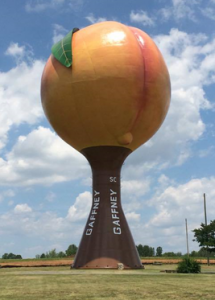#NationalPeachPieDay – Tracing Ingredients Through Material Handling
By Alex Batty, MHI Marketing Communications Coordinator |@mhi_alex
It’s National Peach Pie Day, and while I’m not personally a pie person (alliteration FTW), I thought this was a grand opportunity to take a look at some material handling.
Because while you may be able to pop out to your local Walmart (or other grocer for you Walmart haters) and pick up all the ingredients you need for the pie, they most likely have to come from somewhere else.
And I tracked that down for you. You’re welcome.
Since I’ve never made peach pie, I started by googling a recipe. Here’s what I have, don’t shout at me if it’s not the “right” way to make peach pie.
pastry for a double-crust 9-inch pie
5 cups fresh peaches, sliced
1 cup sugar
1⁄3-1⁄2 cup all-purpose flour
1⁄4-1⁄2 teaspoon cinnamon
2 tablespoons butter
2 tablespoons sugar
I’m going to skip the pie crust, because I honestly buy mine pre-made from the freezer section and there was no “made in” label. I looked. (I even went to Walmart on my lunch break just to check – y’all should feel so special.)
Peaches
We grow these here in the US, so I’m going to presume that most of the peaches you can get at your local grocer are US grown. Cheaper shipping when you don’t have to go through customs and all. Many areas claim peaches as their own. Georgia, who’s nickname is literally “The Peach State.” California, grower of many things tasty. And even South Carolina, which I can see from my office window. (I’m 100% serious. I can literally see into the next state from here.) If I’m getting peaches and it’s peach season, they’re probably coming from South Carolina. They even have a giant peach reservoir in Gaffney that I’ve passed a few times and my friends and I snickered at (for… reasons).
The supply chain here is pretty simple. I get in my car. I find a fruit stand. I bring them home. There is more supply chain before that in how they get to the stand, but I’m not concerned with that when I’m seeking juicy peach deliciousness.
Sugar
I think we’re all aware that sugar comes from sugar cane, but did you also know that it comes from the root of sugar beets? I actually was pre-aware of this fact prior to researching for this post. I lived in the Boise-Nampa metropolitan area, and there was a sugar beet factory just down the road, near our grocery store. It smelled bad. Like really bad. But sugar is tasty, so we dealt with it.
Okay, so apparently the world’s largest exporter of sugar (by a large margin) is Brazil, so we’re going to go with that. I can’t find anything specific, but most likely your sugar is shipped from Brazil (Rio de Janeiro most likely) to the US (Miami is likely) and then transported overland to individual distribution centers. Trucking is the most likely culprit, but if the final destination is the Eastern US, trains may be more widely utilized.
Sugar is a moisture-sensitive cargo, so while it’s traveling, especially across the ocean, it needs to be kept away from running water and the humidity levels need to remain fairly stable, nothing above 80-85%. You can get way more detail at http://www.cargohandbook.com/index.php/Sugar_(raw_and_refined)
Flour
Did you know there is an entire educational website dedicated to grain chain? Like supply chain, but specifically for grain. (grainchain.com)
Wheat is the principal cereal grain grown in the US. The largest producers of winter wheat in the US are Kansas (which I figured) and North Dakota (which surprised me a bit). But there are also wheat farms just up the road in Beaufort, NC. So the flour I eat might just come from there. But the supply chain is pretty visible. Grow it on the farm, truck it to a mill, distribute the flour (probably via truck again).
Cinnamon
You’ve probably never had what plant people consider true cinnamon. The Cinnamomum family are evergreen trees that grow in southeast Asia. True cinnamon, Cinnamomum verum, is actually rarely grown commercially for spice. Cinnamomum cassia, called cassia, is what you’re actually getting at the supermarket. Cinnamon is powered bark off the cinnamon tree. So now you can totally tell people “I had bark for breakfast” when you have cinnamon on your oatmeal.
Cassia is primarily grown in China (and extends to Vietnam), so if we trace that supply chain to Charlotte, NC, we have a boat, that probably docks in Los Angeles, where it can be trucked or flown across the country to the good ol’ NC. I can’t find a good source, but it is most likely shipped internationally as cinnamon sticks (literally rolls of bark) and then ground domestically to give sellers the option to sell as whole sticks or ground. The sticks are also probably a little sturdier and less messy in transit.
(Randomly, when you google ‘shipping cinnamon’ most of the results are about shipping cinnamon rolls. Are there that many people looking to mail a cinnamon roll to someone?)
Butter
I think we all know where butter comes from (…Cows. Cows, people). I’ve even made it at fairs by shaking the cream/salt starter in a baby food jar (so much shaking). But the interesting thing about butter in supply chain is that it has to be refrigerated. And that always adds complications. You need to account for temperature control, the extra energy need to run the refrigeration as well as the vehicle, and time becomes very important to prevent spoilage. A lot of refrigerated shipping today is monitored through sensors and Industrial Internet of Things to give pinpoint accurate data about the foodstuffs.
Now you know (mostly) how your peach pie came to be. Gotta get those ingredients from somewhere, and supply chain makes everything possible, even peach pie.







